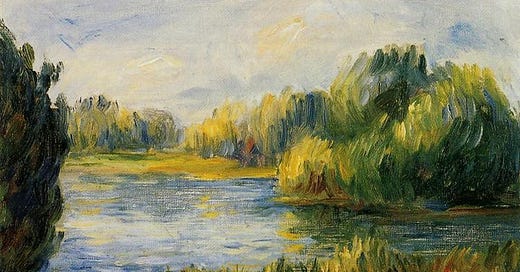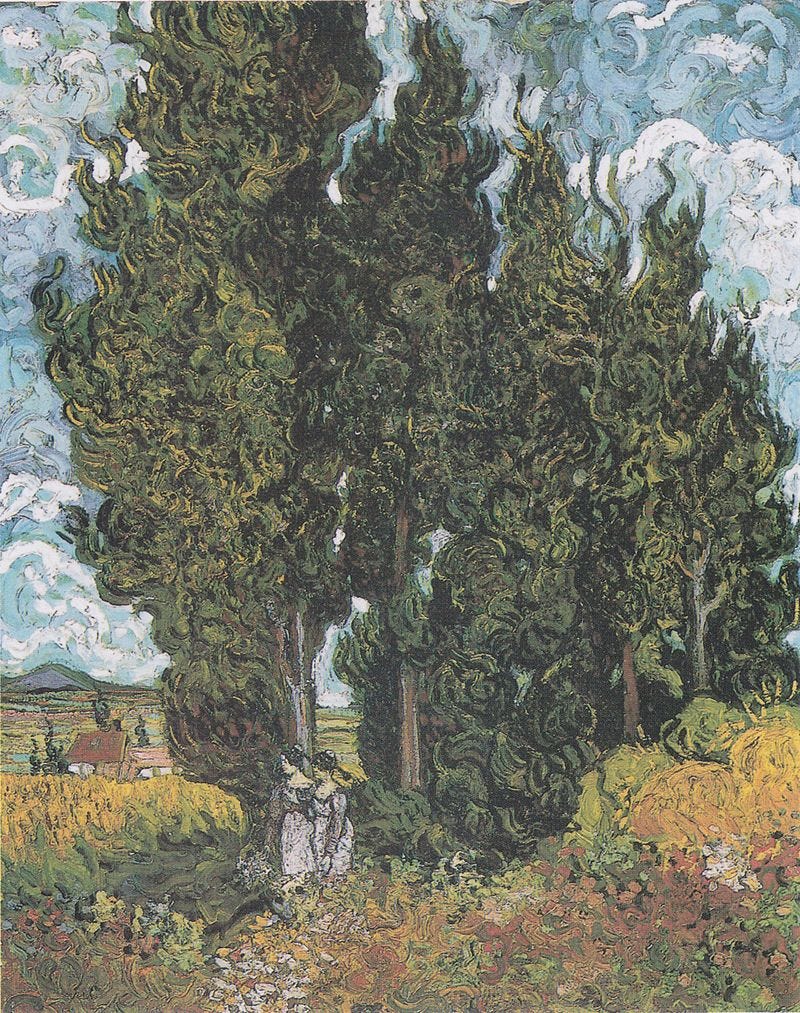A recent rereading of L’Enfant et la rivière, by Henri Bosco, has brought back to mind vast ranges of childhood worlds I used to inhabit in the freedom of imagination afforded by those years. As the book’s protagonist Pascalet travels downstream with the taciturn Gatzo, he encounters the profligate beauty and peace of the fluvial and riparian worlds, which are entirely his own to inhabit. Being boys of around ten, he and Gatzo dwell there in the awareness of danger or necessity or the demands of the future, but without quite feeling them, without caring or perhaps truly believing that they could have any claim that could distract from the splashing birds and whispering reeds. The atmosphere is one of eternality, of enchantment, and time—that is, adult, clock-time—has no dominion there.
Though I have not had the great fortune to be lost upon a French rivière, I was blessed in growing up in the country, more or less, and many of my most formative memories involve the natural world. Yet unlike the journey of Pascalet and Gatzo, much of my time in nature has coincided with a desire to restructure the environment in creative ways. Where the protagonists of Bosco’s novel drift peacefully downstream, explorers in a mystery, many of my own memories of the outdoors involve a thirst to involve myself with its structures—in short, to build a human sphere within and apart of the larger natural spheres that so enchanted me as a child.
I recall, for instance, cutting my way into a blackberry patch when I was around Pascalet’s age, or somewhat younger, and building amphitheaters and domes scarcely large enough to hold my frame but that might have been palaces for the joy I took in them. I dreamed of digging underground homes and tunnels that connected to the underground spaces where my friends could dwell. Some of us even began to dig in an effort to achieve this dream, though the others abandoned me and I moved only enough earth to form a shallow grave.
Perhaps it was around this time also that I read a book, the title and author of which I cannot recall, in which a young man plants a garden round his home. It grows to such heights that he takes up residence there, growing and making all he needs from the plants about him—clothes, hats, food, shelter. He creates pen and ink from berries and invents his own language. He lounges there, in the treehouses and hammocks of an earth that is all his own, and knows the full fruitfulness of himself in communion with the life of nature, beginning with the most basic necessities but expanding to, eventually, the heights of literature, of culture.
The desire for such communion and creative unfolding has long been near my heart, and may explain my love of RTS games like Age of Empires and my fascination with gardens, permaculture, natural building, and so on. To build not just a small monument or item of beauty but an entire ecosystem, a whole world, not excluding the world of culture, has long struck me as something of a primordial desire, a fire that motivates perhaps even more than necessity the flourishing of civilizations. The shame of it is that it is so bound to necessity and that each member of such projects can see and contribute only the minutest of portions while being crushed under the wheels of violence and disaster that ever dominate history.
Indeed, it is fair to question whether these two impulses—to commune and to build—are compatible at all, especially in the face of an increasingly murderous and noxious Anthropocene, in which human culture appears to have set itself against the natural webs with which it is inextricably linked. To what extent can civilization extend before it comes into conflict with its environmental context? Is it possible for the two to live in harmony at all?
For myself, I see no reason why humanity and nature must exist in perpetual tension, for the two are not really separate; human beings are part of nature, no matter how our astonishing creative capacities may allow us to ignore or actively combat this reality. Rather than viewing the impulse to creative activity as in conflict with a reverence for the natural, then, it would be better to understand the two as complementary. For we can only inhabit the natural as human beings, as creatures prone to creative transformation of our environment, and nature provides the materials and the context for everything we build. It is only when we understand our environment as something worthy of reverence, moreover, that we are capable of creative endeavors that violate neither the environment nor our own humanity, which is largely an outgrowth of that environment, inextricably linked with it.
In such a balance, reverence and creativity mutually reinforce one another. When we allow our creativity to be guided by our reverence, the result is that nature can guide us to ever greater heights of both ingenuity and beauty. Think of the designs of Japanese katanas in which the pattern of the blade’s steal is modeled on the silhouettes of forests or of clouds. Consider the number of scientific and technological innovations that have arisen from a careful study of the mechanisms and pharmacology of insects and plants. Examine the acanthus leaves on the pillars of so many Venetian churches. Culture invariably grows out of its context, and the more reverence and respect a culture has for its environment, the richer that culture will be. I believe this is simply self-evident. So much of what is most hideous in the modern world is its abstraction, its failure to root itself in the particular realities of context. Certainly in America, much architecture has no relationship to the landscape, the climate, or local history. Our food, likewise, is often entirely unrelated to what can be grown in a given time or place, much less what might be native to an area.
I am not, as it happens, advocating for the restriction of cultural exchange or demanding that artists, builders, or cooks never employ resources or ideas borrowed from other contexts. Nevertheless, it seems to me that our creative endeavors are most likely to be harmonious and beautiful when they spring from a love and admiration of what is good in our own context, and that this is the most appropriate foundation upon which one can begin to appreciate the endeavors of other times and places. If one chooses to borrow from another context, this ought not to be done in pure abstraction, as if that borrowing did not transpose the other and transform it in the process.
All of this is a very roundabout way of saying that the childlike perspective is the best. We must begin, like Pascalet and Gatzo, with immersion, with a love for the mystery of the natural, for the birds reflected in the clarity of waters, the shade beneath the boughs, the fish swimming above the polished stones. But we cannot deny our human impulse for creative transforming, only ground it in that love and reverence. For this impulse, though it frequently becomes perverse, need not tend to domination or conflict, but to peaceful inhabitation. In thus inhabiting the world as we encounter it as a whole, not in abstract parts, we allow it to inhabit us, so that its spirit extends itself into further forms, forms that meet practical, aesthetic, and even spiritual needs. And these forms may grow and travel, creating dynamic and creative relationships with those of other times and places, but only if they are at least initially rooted in the contexts that gave them life.






![Byzantine acanthuses on the cornice at the top of the Pilastri Acritani (Pillars of Acre), originally in the Church of St. Polyeuctus, later taken and now displayed in the Piazzetta di San Marco, Venice, unknown architect or sculptor, 524-527[6] Byzantine acanthuses on the cornice at the top of the Pilastri Acritani (Pillars of Acre), originally in the Church of St. Polyeuctus, later taken and now displayed in the Piazzetta di San Marco, Venice, unknown architect or sculptor, 524-527[6]](https://substackcdn.com/image/fetch/$s_!ZMSo!,w_1456,c_limit,f_auto,q_auto:good,fl_progressive:steep/https%3A%2F%2Fsubstack-post-media.s3.amazonaws.com%2Fpublic%2Fimages%2F41a5f0fc-fbbb-45e3-97b8-8b2096b4efa8_1280x960.jpeg)
This is very timely. I’m on the cusp of the birth of child number three, who will be named Bosco due to my obsessive (quite literally pathological) reading of Malicroix.
I wish I could read French, primarily so I could read more Bosco (seriously, every other reason is a distant second place at best).
On your thesis, I completely agree.